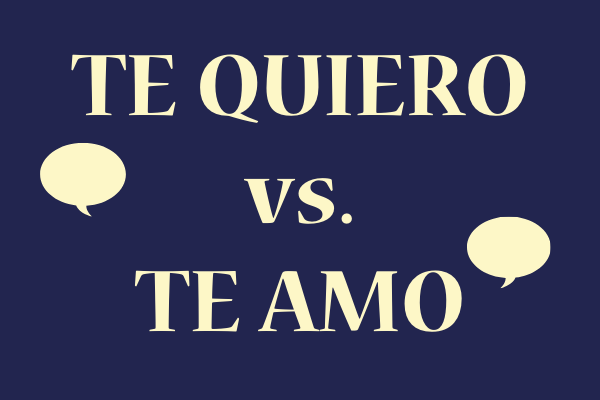Te quiero vs. Te amo
The question of when to say Te quiero and when to say Te amo is a big source of confusion in Spanish as a foreign language circles. These two terms are largely context driven; both changing depending on where you are, who you're speaking to, and the emotions you are trying to convey.
To understand the root of this dilemma, we have to consider the different kinds of love there are along with the different ways we use the word ‘love’ in English. This could offer some insight on how we can express love using the terms Te queiro and Te amo in Spanish.
Let’s first have a look at three different types of love: platonic, romantic, and familial.
Platonic Love
Platonic love is the type of love we have to our friends. It encompasses compassion, loyalty, empathy, and sympathy. We express platonic love easily and without hesitancy to those we like a lot. In platonic love, often the actual word ‘love’ is expressed in an ironic or playful way.
Ways we use the word ‘love’ in platonic love:
“Jenny made me Thai food yesterday and I fell in love with it”.
“Jenny, I love you!"
Familial Love
Familial love is the kind of love that we have for our family members, characterized by deep bonds.
Ways to express familial ‘love’:
“Happy Valentine’s Day Mom, I love you!”
Romantic Love
Romantic love is the love you feel for a person you want an intimate relationship with; when you feel ‘in love’. Saying “I love you” when you’re in a romantic relationship can be considered deeply profound and even a milestone.
Ways to Express ‘love’ romantic love:
“I think I’m falling in love with you.”
“I am in love with you.”
One aspect of romantic love that highly distinguishes itself from other forms of love when it is expressed using the term ‘love’, is the condition of being ‘in’ love.
“I love you but I’m not in love with you,” is a common way of rejecting a friend’s request to make things romantic.
Just like English, how we express love in Spanish is highly dependent on the type of love we want to express, except in Spanish we have two terms we can use instead of one.
What do Te quiero and Te amo mean?
The terms Te quiero and Te amo are derived from the verbs querer (to want) and amar (to love). Te quiero and Te amo can both mean “I love you”. The difference is that Te amo is considered more intimate, while Te quiero is considered more casual. Depending on how it’s said, Te quiero can also mean “l want you”.
Te quiero literally means “I want you” but its most common meaning is “I love you’ and is considered an appropriate way to express platonic love. This can be quite confusing to English speakers because ‘want‘, when directed at a person, expresses more of a physical desire rather than platonic or romantic love. Nonetheless, if you’re having a heart-to-heart with your friend, you can say Te quiero to express the importance they hold for you and that you care for them deeply. However, just like English, how you say it is a big factor.
You could also express Te quiero to a person you are casually dating, but just haven’t quite reached the next level of your relationship with. In English, saying the words “I love you” in a romantic context raises the stakes for the speaker. As a result, there are different ways to express how much someone means to us without jumping off the deep end, such as “I’m into you”. In Spanish, we use Te quiero. Think of it as a midway point between Me gustas and Te amo - perhaps you really like the person but you just don’t think you’re in love yet.
Te amo is used to express deep romantic sentiments, the feeling of being ‘in love‘. Te amo is appropriate for romantic partners; however, teenagers and young adults say Te amo these days to their best friends. Some native speakers consider Te amo to be quite old-fashioned and young lovers would not say it to each other.
Other ways to express romantic love in Spanish:
“Tengo ganas de estar contigo.”
“I want to be with you.’’
“Te deseo mucho.”
“I really desire you.“
‘‘Estás muy atractiva, me gustas mucho.”
“You're very attractive, I really like you.’’
Are you looking for the right way to tell someone “te amo”? Our Online Language Spanish or Maya Gift Packs make the perfect gift for loved ones for any occasion. They feature five hours of 1-on-1 language classes with an expert native-speaking teacher and much more. The best part? Your gift also helps support subsidized language classes for local students in Felipe Carrillo Puerto!

